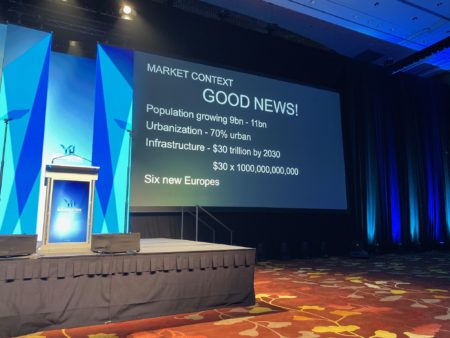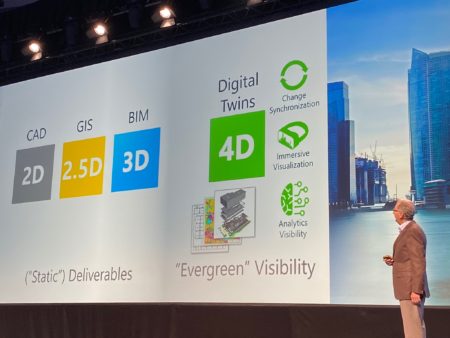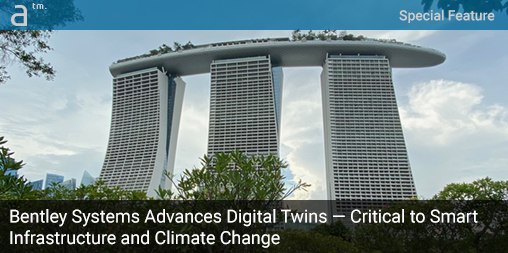FROM THEIR EARLIEST DAYS BENTLEY SYSTEMS’ customers were involved in infrastructure—capturing interest from engineers involved in transportation and utilities—large engineering outfits who were some of the early first customers of CAD when it was run on mini-computers and Intergraph workstations. With the emergence of the PC in the early-mid 1980s, early CAD users took an interest in aspects of the personal computer that, in today’s parlance, we might term “democratization” of tech.
Today we talk about how the cloud and mobile democratize access to information. Back then, engineers wanted to be liberated from the tethering requirements of terminals and mini-computers. The PC was the answer they were looking for. And Bentley seized on this with the first versions of Microstation. More than three decades later, Bentley is a global leader in software for infrastructure design, construct, and operations professionals, and this market position couldn’t be more aptly timed for strong long-term growth. But to understand this growth, we must look at the key factor driving it: an exploding world population.
Global Infrastructure at Scale
The World Economic Forum has written that the world has an $800 billion annual infrastructure gap. Despite the trillions spent annually on big capital projects like water, power, energy, transportation, and telecom, the pace of infrastructure expenditure isn’t keeping pace with a growing world. In 2016, McKinsey Global Institute reported that we should be spending $3.3 trillion a year just to meet expected economic growth out to 2030, but the actual spend is $2.5 trillion. There’s our $800 billion gap.
And what of this growing world of ours?
The world is adding 83 million new people annually or about 1.1% per year global population growth. That’s like adding eight new New York Cities worth of humans to the planet each year. Each new person adds to existing resource needs for core survival basics like water and food and shelter. But additionally, for power, energy, transportation, and telecom. Those last items, including the core first items, require infrastructure.

A night shot of the city of Mumbai, India, from across Back Bay. Some of the largest growing cities are in developing countries like India. Asia, South Asia, and South East Asia are all experiencing dramatic growth, in population, urban population percentage, or both. (copyright: Wikipedia Commons)
A great way to see this growth is to look at the world population growth clock on the net. While some argue that our global population will peak mid-century at 9 billion and then slowly decline, others say it will reach 11 billion by 2100 and continue to grow thereafter. Either way, for the next few decades until mid-century, planet Earth is going to need to sustain about 2.2 billion more human lives and 1 billion more from 2018 to 2030 alone.
Let’s put those last two numbers in context. It took from the dawn of time for humans to reach 1 billion in the year 1800. Then in just 127 years (1927), we reached 2 billion, doubling the world population. Think of the world’s cities and infrastructure in 1927 and note that we need to essentially add that to the planet again from now until 2050. Because the human population is essentially becoming more urban, some have stated that we need to actually build one new New York City worth of infrastructure per month (12 per year not 8, as noted above).
Buy a shotgun, because there’s going to be mass migration, there’s going to be mass upheavel, there’s going to be mass extinction. This is science, and it is now.
To recap, due to our global population growth rate (1.1%), we need to build out a New York City’s worth of infrastructure investment every month around the globe to address adding 83 million more people living on Earth each year. Not only is Bentley Systems strategically best positioned to benefit from this global infrastructure expansion, but it is also preparing to address the deeper questions—like how will Earth support this on a resource level? How do we manage the environmental impact and carbon expenditure?
Digital Twins Can Help Save Us (and Earth)
During Bentley’s 2019 Year in Infrastructure Conference, held in Singapore, this past October, former Atkins boss and architect, Keith Clarke, CBE, gave the most riveting talk of the entire event. The current chair of the climate advocacy group, Forum for the Future, the former construction industry executive warned that if global warming exceeded 1.5 degree celsius between 2030 and 2050 it would impact the wellbeing and security of hundreds of millions of people.

Keith Clarke, CBE, speaking at the Bentley 2019 Year in Infrastructure. (image: Bentley Systems / Architosh. All rights reserved.)
McKinsey noted above we need to be building $3.3 trillion a year but are only doing $2.6 trillion a year in infrastructure development. Clarke noted that infrastructure had a major role to play in reducing global emissions. Noting that $30 trillion worth of assets are set to be built around the world between now (2019) and 2030 (the math works out to $2.7 trillion per year), Clarke said that it is equivalent to six times the existing infrastructure and buildings in Europe today.

Keith Clarke, CBE, speaking at the Bentley 2019 Year in Infrastructure, tells the audience we will build the equal of six Europe’s from now until 2030. The population is estimated to hit 9bn in 2050 and 11bn in 2100. (image: Architosh. All rights reserved.)
Imagine the construction emissions impact of six Europe’s built over just eleven years. Clarke’s fundamental message was that carbon reductions had to become fundamental to how we build now—not later when we exceed 1.5°C but right now—while we still have a fighting chance to prevent an Earth so warm that the polar ice caps disappear entirely, rising sea levels to amounts that will impact and flood cities around the world—many in areas already critically low—like Bangladesh, home to 163 million people.

Keith Clarke, CBE, speaking at the Bentley 2019 Year in Infrastructure, tells the audience we must make carbon-neutral goals an immediate priority to maintain 1.5° C by 2050 to prevent dramatic climate change like the complete melting of the polar ice caps. (image: Architosh. All rights reserved.)
Bentley is producing the technology to help reduce the carbon emissions impact on global infrastructure, first and foremost, through the technology of “digital twins.” As Greg Bentley noted in his keynote, Digital Twins are part of the evolution from 2D CAD to 3D BIM to 4D Digital Twins. However, digital twins in the fullest sense include life-cycle data, which within the parlance of BIM world corresponds to 6D BIM, with 4D (fourth dimension) adding “time” to 3D BIM, 5D (fifth dimension) adding “costs” to 4D BIM, and 6D (sixth dimension) adding “life-cycle data” to 4D-5D BIM.

Greg Bentley, CEO of Bentley Systems, talking about his company’s technology around Digital Twins, which provides “Evergreen” visibility into the project/asset across its lifecycle from design inception to operation and beyond. A digital twin of a physical asset like a bridge or train station is theoretically available to asset owners, managers, and design and engineering professionals, even if that physical asset has been demolished. (image: Architosh. All rights reserved.)
I found Greg Bentley’s charts and diagrams curious in this respect to the “many dimensions” of BIM. Regardless, the message is clear, Bentley means life-cycle data, which subsumes time and costs data.
Bentley’s stack of technologies, from applications to services to partnerships, means infrastructure projects can be designed, built, and operated with greater efficiencies. McKinsey’s “Bridging Global Infrastructure Gaps” 45-page report notes that making infrastructure spending more effective helps address the shortfall of needed global infrastructure by improving project selection, delivery, and management of assets. McKinsey’s research shows that emerging technologies—the very subject of this newsletter—can boost productivity by 25-30 percent. Such technologies cited include higher-definition surveying and geo-location, next-gen 5D building information management (BIM+FM) software, AR devices, digital collaboration and mobility (CDEs), and finally IoT (sensors) and advanced analytics.

Greg Bentley, CEO of Bentley Systems, talking about his company’s technology around Digital Twins. Digital Twins merge three key aspects that go far beyond BIM—(1) ‘Digital Chronology’ adding the key component of time (iTwin Cloud Services) to both design and operations, (2) ‘Digital Context’ through reality capture technology, again data that has been time-stamped, and (3) ‘Digital Components’ which merge their engineering design tools with machine learning (AI) so that infrastructure professionals can make smarter design and operations decisions. (image: Architosh. All rights reserved.)
Without a doubt, the infrastructure industry has a long way to go to capture these double-digit productivity boosts. Bentley’s digital twin technologies now consist of new iTwin Services with connected cloud-based collaboration, simulation, and analytics. The new iTwin Cloud Services federate engineering content from BIM design tools, engineering tools, and multiple data sources, “enable 4D visualization of digital twins, and log engineering changes along a project/asset timeline, to provide an accountable record of who-changed-what-and-when.”
Bentley’s new offerings are built on its iModel.js open-source platform for digital twins. The open-source nature of this technology is aimed at developing a digital twin ecosystem with third-party support, some of which were on display in Singapore at the conference. Open-sourcing enables owner-operators to integrate their own or other company’s tools with the Bentley digital twin ecosystem.
To further drive industry adoption, utilization, and interoperability with Bentley products and services, the company announced new membership status with buildingSMART International (bSMI) with new support for IFC for Digital Twins. Bentley announced iModel Bridge for IFC, a way to get IFC geometry data into its iModel format and system. iTwin Services can now enable iModels to export snapshots in IFC and treat IFC datasets as an input source. These latest moves provide exciting new interoperability capabilities for architects, engineers, and contractors to work across various discipline applications—more easily moving project and asset data from design and management applications to digital twins in the cloud.
Closing Thoughts
Smart Cities will consist of connected infrastructure with connected services optimized and personalized through artificial intelligence. This was a message of Dr. Ayesha Khanna’s keynote on Smart Cities and AI, who gave a detailed example of her work to bring connected mobility services to citizens through a single and intelligent mobile app. Her example demonstrated the virtuous benefits of smart city technologies hitting on aspects of human health and happiness in addition to functional benefits for assets like smart scooters, autonomous cars, buses and rail, and improved traffic conditions.

Dr. Ayesha Khanna offered an exciting and thought-provoking keynote on Smart Cities and Artificial Intelligence (AI). (image: Bentley Systems / Architosh. All rights reserved.)
In a world with smart connected assets, IoT sensors obtaining real-time data on operations and systems performance feed intelligent dashboard apps enabling infrastructure owners and managers critical data to improve asset performance—across multiple metrics from power utilization, maintenance, and asset performance metrics.
With its combination of MicroStation-based Open-branded design apps, ProjectWise and AssetWise, iTwin Cloud Services and iModel.js open-source platform tech stack, and various engineering and simulation tools, Bentley sits in a unique position to further the digitization of infrastructure and construction. And in doing so, it can help close the infrastructure spending gap by helping asset owners and managers design, build and run infrastructure more efficiently and with a smaller carbon footprint.




Reader Comments
[…] Bentley Systems Advances Digital Twins—Critical to Smart Infrastructure and Climate Change Architosh […]
Comments are closed.